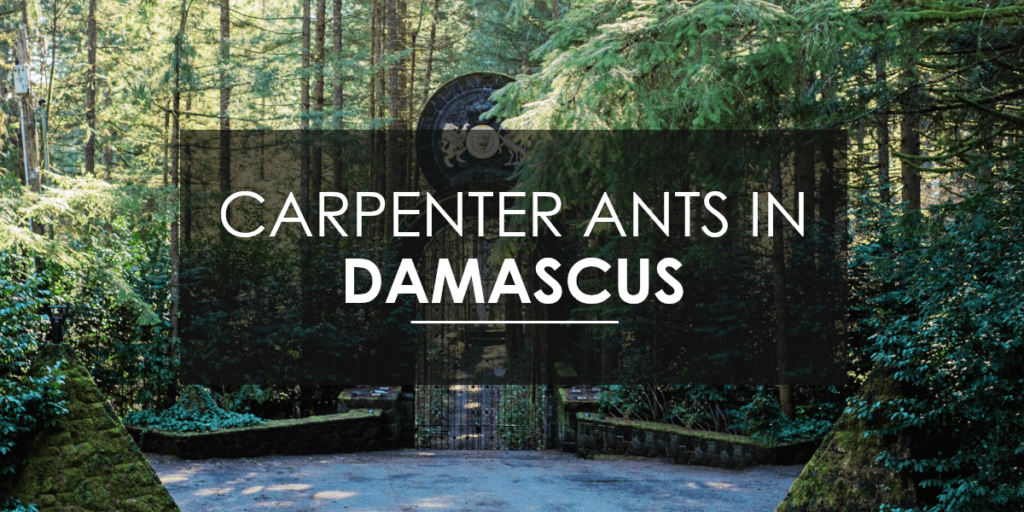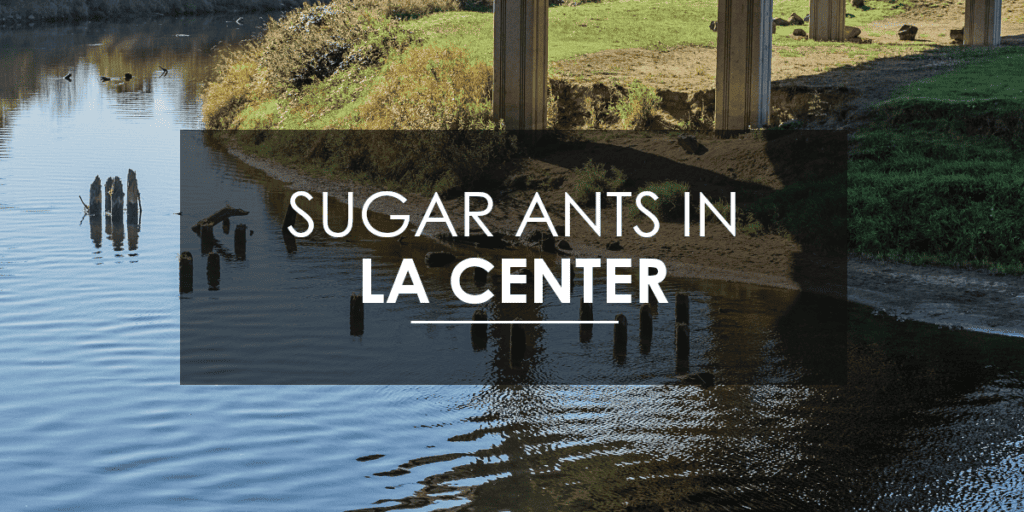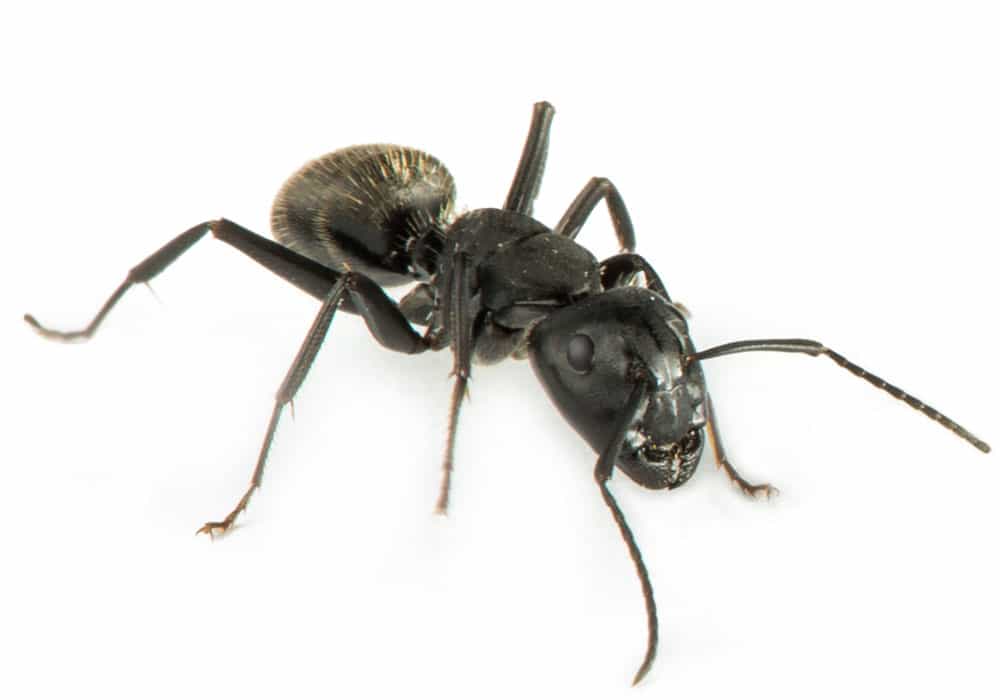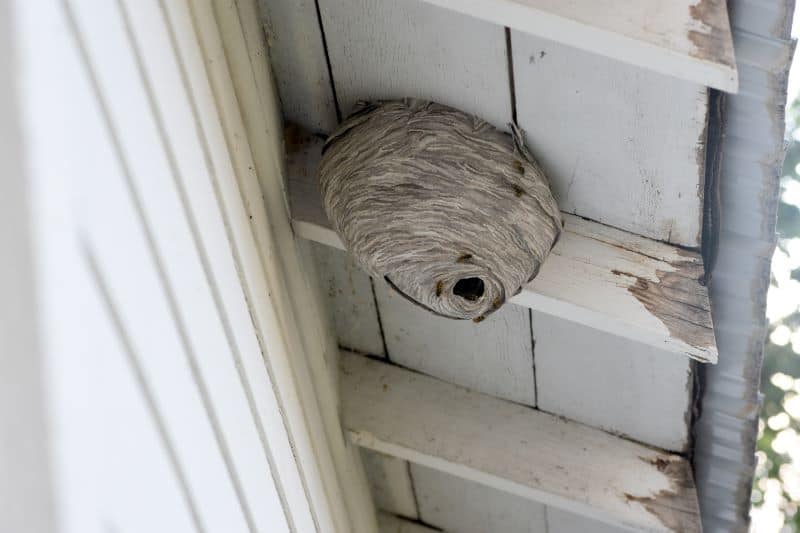Sugar ants may be tiny, but they can be a big nuisance for homeowners in Woodland, WA. These tiny pests can quickly invade homes in search of food, leaving trails of ants and causing frustration for residents. In this guide, we’ll discuss how to identify sugar ants, why they’re attracted to the home, steps you can take to deter them, and the benefits of choosing quarterly service from Aspen Pest Control for effective sugar ant control and removal.

How to identify Sugar Ants
To control sugar ants, you first need to identify them. They can be identified by observing their physical and behavioral characteristics. Here’s a detailed guide on how to identify sugar ants:
Physical Characteristics of Sugar Ants
1. Size and Color:
- Sugar ants are relatively small, typically ranging from 2.4 to 3.25 mm in length.
- Worker ants are usually uniform in size, but there may be slight variations.
- They are light to dark brown or black in color.
2. Body Structure:
- Sugar ants have a distinctive segmented body with three main parts: head, thorax, and abdomen.
- The head typically has a pair of bent antennae and strong mandibles (jaws).
- The thorax, which connects the head and abdomen, is narrow.
- The abdomen is more prominent and may have one or two nodes (bumps) between the thorax and abdomen.
3. Winged Reproductive Ants:
- Winged reproductive ants, also known as swarmers or alates, may be present during mating seasons.
- These winged ants have two pairs of wings of unequal length, and they typically appear larger than worker ants.
4. Distinctive, Unpleasant Odor:
- Sugar ants, also known as odorous house ants (Tapinoma sessile), emit a foul odor when crushed. Many compare it to a rotten coconut smell.
Behavioral Characteristics of Sugar Ants
5. Foraging Patterns:
- Sugar ants are often seen in trails, moving in a line from their nest to a food source.
- They are particularly attracted to sweet substances but may also feed on fats and proteins.
6. Nesting Sites:
- Sugar ants commonly nest indoors in walls, under flooring, in voids, and around damp or moist areas.
- Outdoors, they may nest in soil, under rocks, or in decaying wood.
7. Attracted to Moisture:
- Sugar ants are drawn to moisture, so you may find them in kitchens, bathrooms, or areas with water leaks.
8. Feeding Habits:
- They are named “sugar ants” due to their preference for sugary foods, but they also consume a variety of other food sources.
- The presence of sugar ant trails leading to food sources is a common indicator.
9. Communication:
- Sugar ants use pheromones to communicate with each other, leaving scent trails that guide other ants to food sources.
Observation Tips to Identify Sugar Ants
10. Patience and Close Observation:
- To identify sugar ants, take your time observing their movement and appearance.
- Use a magnifying glass for a closer look if necessary.
11. Inspect Potential Nesting Sites:
- Look for ant trails leading to potential nesting sites, both inside and outside the house.
- Check for small openings, cracks, or crevices near these trails.
12. Examine Winged Ants:
- If you observe winged ants, especially during the Spring mating season, it may indicate a mature colony with reproductive ants.
13. Compare with Reference Images:
- Use online resources or field guides to compare the ants you observe with reference images of sugar ants.
Remember that proper identification is crucial for effective sugar ant management. If you need more clarification about the identification or if you’re dealing with a significant infestation, contact us for a free consultation with one of our pest control professionals for accurate identification and appropriate treatment options.
Understanding Sugar Ants’ Attraction to Your Home’s Exterior
Understanding why sugar ants are attracted to the exterior of your home is essential for effectively managing and preventing infestations. Several factors may inadvertently draw sugar ants to your property, many of which can be attributed to landscaping choices and plant selection. In this section, we’ll explore these attractants in detail and provide practical solutions to help you deter sugar ants from nesting around the exterior of your home. From overgrown vegetation to organic mulch beds and excessive moisture, we’ll cover each attractant and offer actionable steps you can take to minimize their impact on ant activity. By implementing these solutions, you can produce a landscape that is less hospitable to sugar ants and enjoy a pest-free outdoor environment.
1. Overgrown Vegetation:
- Dense vegetation, such as overgrown shrubs, bushes, and ground cover, can create hiding spots and nesting sites for sugar ants. These areas provide shelter and protection, making them attractive habitats for ants seeking refuge from the elements.
- Solution: Regularly trim and prune dense vegetation to reduce hiding spots and nesting sites for sugar ants. Keep landscaping tidy and well-maintained to minimize potential habitats for ants.
2. Organic Mulch Beds:
- Although mulch can help retain moisture and suppress weeds, certain types of mulch, such as organic mulches like wood chips or bark, can create ideal conditions for sugar ants. Organic mulches provide organic matter for ants to feed on and can retain moisture, creating a moist environment that sugar ants are drawn to for nesting.
- Solution: Use mulch made from materials known to repel ants, such as cedar or diatomaceous earth. Otherwise, opt for inorganic mulch options like gravel or rubber mulch, as these do not provide food sources or retain moisture like organic mulches, making them less attractive to sugar ants.
3. Excessive Moisture:
- Areas with poor drainage or standing water can attract sugar ants, as these insects require moisture to survive. Overwatered lawns, flower beds, or garden areas can create moist conditions that are conducive to sugar ant infestations.
- Solution: Improve drainage in areas with poor drainage or standing water to reduce moisture levels. Avoid overwatering lawns, flower beds, or garden areas, and address any leaks or irrigation issues promptly to minimize moisture attractants for sugar ants.
4. Plants with Aphids:
- Sugar ants are attracted to honeydew-producing insects like aphids. Plants hosting aphids, such as roses or ornamental plants, can draw sugar ants to your garden. Aphids secrete a sugary substance (honeydew), providing a food source for sugar ants.
- Solution: Avoid plants with aphids: Choose plants that are less prone to aphid infestations to minimize honeydew production. Regularly inspect plants for aphid activity and address infestations promptly.
5. Flowering Plants with Nectar:
- Some flowering plants, such as honeysuckle, produce nectar, which may attract sugar ants seeking additional food sources. While these varieties of flowering plants are not the primary attraction, the presence of nectar can enhance the overall attractiveness of an area to sugar ants.
- Solution: While flowering plants with nectar can attract sugar ants, maintaining a balanced landscape with a variety of plant species can help mitigate their attraction. Consider incorporating plants with less sugary nectar or low attractiveness to sugar ants, such as mint, peppermint, and bay leaves. Introducing these plants to your garden or near entry points can act as a deterrent for sugar ants.
6. Plants with Extrafloral Nectaries:
- Certain plants have extrafloral nectaries (nectar-producing glands on non-floral parts), which can attract sugar ants. Examples include passionflower, hibiscus, and sunflower. These nectaries provide a supplemental food source for ants, encouraging them to forage in the vicinity.
- Solution: Monitor plants with extrafloral nectaries and consider removing or replacing them with species less attractive to sugar ants. Alternatively, encourage natural predators of sugar ants, such as birds or predatory insects, to help control ant populations.
7. Fruit Trees:
- Fruit trees, such as apple, cherry, or plum trees, can attract sugar ants when fruits ripen and fall to the ground. Fallen fruit provides a readily available food source for sugar ants, encouraging them to forage in the area.
- Solution: Harvest ripe fruits promptly and remove fallen fruit from the ground to eliminate a food source for sugar ants. Prune fruit trees regularly to maintain tree health and reduce the likelihood of infestations.
8. Unmaintained Gardens:
- Gardens that are not properly maintained, with weeds, decaying plant matter, or fallen leaves left to accumulate, can provide food and shelter for sugar ants.
- Solution: Regularly weed, clean up decaying plant matter, and remove fallen leaves to eliminate potential food and shelter sources for sugar ants. Keep garden beds well-maintained and tidy to discourage ant activity.
9. Leaky Irrigation Systems:
- Irrigation systems that leak or drip water can create moist conditions in the soil, attracting sugar ants.
- Solution: Inspect and repair leaky irrigation systems to prevent excess moisture accumulation in the soil. Consider installing drip irrigation systems or using soaker hoses to minimize water runoff and reduce attractants for sugar ants.
Recognizing the factors that attract sugar ants to the exterior of your Woodland home is vital for effectively managing and preventing infestations. By understanding how landscaping choices and plant selection can inadvertently create favorable conditions for sugar ants, you can take proactive steps to deter their presence. From maintaining vegetation and opting for ant-repellent mulch to addressing moisture issues and controlling aphid populations, there are various solutions available to minimize attractants for sugar ants. As you implement these solutions, you can create a landscape that is less hospitable to sugar ants, reducing the risk of infestations and ensuring a pest-free outdoor environment for your home.

Understanding Sugar Ants’ Attraction to Your Home’s Interior
Sugar ants can become unwelcome guests in any home, drawn by various factors that make your indoor environment appealing to them. From the availability of food sources to conducive nesting opportunities, there are several reasons why sugar ants might find your home’s interior attractive. In this section, we’ll delve into these reasons and provide effective solutions that you can implement to deter sugar ants. By addressing these attractants, you can help keep your Woodland home free from unwanted ant infestations and maintain a clean and hygienic living space for you and your family.
1. Availability of Food Sources:
- Sugar ants are attracted to a wide range of foods, with a preference for sugary substances. Common food sources include spilled sugar, honey, syrup, fruit juice, and crumbs. Improperly stored food, especially in kitchens and pantries, can provide easy access for sugar ants.
- Solution: Store food in airtight containers and promptly clean up spills and crumbs. Regularly sanitize food preparation areas to eliminate enticing food odors.
2. Moisture and Water Sources:
- The Pacific Northwest has a temperate climate and ample rainfall, creating suitable conditions for sugar ants. Areas with excess moisture, such as leaking pipes, dripping faucets, or damp spaces in the home, attract sugar ants. They seek water for both drinking and establishing nests.
- Solution: Repair leaks promptly, ensure proper ventilation to reduce humidity levels indoors, and use dehumidifiers if necessary. Regularly inspect plumbing fixtures for any signs of leaks.
3. Nesting Opportunities:
- Sugar ants often nest in areas with access to water and food. In the Pacific Northwest, they may establish nests in wall voids, under flooring, and near sources of moisture. Warm and protected indoor environments are attractive for nesting, especially during cooler seasons.
- Solution: Seal cracks and crevices in walls, floors, and foundations to prevent ants from entering the home. Use weatherstripping or caulk to fill in gaps around doors, windows, and utility penetrations.
4. Structural Openings and Entry Points:
- Small cracks, gaps, or openings in the structure of a house provide easy entry for sugar ants. They can exploit even tiny openings to gain access to the interior, seeking shelter, warmth, and food.
- Solution: Conduct a thorough inspection of the home’s exterior and interior to identify and seal potential entry points. Repair damaged door screens and install door sweeps to prevent ants from entering through doors and windows.
5. Scent Trails and Communication:
- Sugar ants communicate using pheromone trails. Once they find a food source, they leave behind a chemical trail for other sugar ants to follow. If a scent trail is not promptly cleaned, it can attract more ants to the area.
- Solution: Clean up spills and crumbs immediately and use vinegar or soapy water to remove scent trails. Regularly sanitize surfaces where ants have been seen to disrupt their communication pathways.
6. Warm Indoor Environments:
- During colder seasons in the Pacific Northwest, sugar ants may seek refuge indoors to maintain warmth. Homes with central heating or insulated spaces can be particularly attractive.
- Solution: Maintain consistent indoor temperatures and use weather stripping around doors and windows to reduce heat loss and discourage ants from seeking shelter indoors.
7. Pet Food and Waste:
- Leftover pet food and food spills can be a food source for sugar ants. In addition to food, they may be attracted to the scent of pet waste.
- Solution: Feed pets indoors and clean up any spilled food immediately. Store pet food in sealed containers and regularly clean pet feeding areas to remove food debris and odors.
Understanding why sugar ants are drawn to your home’s interior is crucial for effectively managing and preventing infestations. By addressing factors such as food sources, moisture, nesting opportunities, structural openings, scent trails, warm environments, and pet food waste, you can significantly reduce the likelihood of sugar ants making themselves at home indoors. Implementing the practical solutions detailed in this section can help you maintain a clean, hygienic living space in your Woodland home, free from the nuisance of sugar ant infestations. Regular maintenance and vigilance help to ensure a pest-free environment for you and your family.

Choose Regular Pest Service from Aspen Pest Control for Guaranteed Results
In conclusion, while implementing the deterrent measures detailed in this article can significantly reduce the risk of sugar ant infestations indoors and outdoors, there is no guarantee that these pests won’t find their way into your Woodland home. However, at Aspen Pest Control, we offer a reliable solution with our Home Protection Plan. With quarterly treatments, we will safeguard your home against the vast majority of pests, including sugar ants. Our convenient and hassle-free service ensures your home remains protected without inconveniencing your schedule. Plus, with unlimited free re-treatments between regular services, you can have peace of mind knowing that we stand by the quality of our work. Our eco-friendly approach ensures the safety of your family and pets while effectively managing pest populations. Don’t wait until sugar ants invade your home – contact Aspen Pest Control today for a free consultation and estimate, and take proactive steps towards a pest-free environment.
If you’re interested in pest control services that are designed to suit your needs, lifestyle, and budget, then contact Aspen Pest Control today for your free quote!







